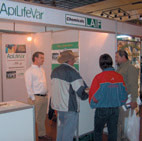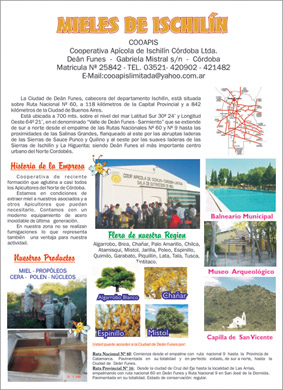|
NOSEMA: Causes, Diagnostic and Treatment
- Gabriel Sarlo
Mar del Plata - Buenos Aires - Argentina
Synthesis of the presentation gave by Edgardo Sarlo, from the Arthropods Laboratory of the Faculty of Exact Sciences - Mar del Plata National University, during the “XIV Fair and Beekeeping Meeting fron the Centre of the Country” last May in San Francisco, Córdoba.
It is a complete upgrade mainly about what is known, until now, of this bee illness, factors that contribute to its development, its diagnosis, its treatment and characteristics that justify the monitoring strategy suggested by Sarlo in "Espacio Apícola" 67th edition (April - May / 2005).
The conference and answers to consultations lasted more than two hours.
"The studies about Nosema that I am presenting, belong to the Southwest of Buenos Aires province and it's going to be shown the situation of that area. - Sarlo starts saying -
This illness has different forms of showing according to the area where the beekeeping activity is developed, because each one of them has its factor to shot the illness and generate those picks that we must try to avoid. We are seeing also some basic handling rules necessary to avoid it, but each area has its particular characteristic."
The subtitles we present the dissertation, with their illustrations and graphics, are the following ones:
- ETIOLOGY - DIAGNOSTIC AND TREATMENT
- NOSEMA THROUGH HISTORY
- PARASITE ENVIRONMENT
- PARASITE CYCLE
- DISSEMINATION OF INFECTIOUS MASSES
- ILLNESS CONSEQUENCES
- CONSEQUENCES IN WINTER AND PRE-SEASON
- CONSEQUENCES IN THE QUEEN BEE AND THE BREEDING
- NOSEMA SHOT FACTORS
1. - CLIMATIC FACTOR
2. - HUMAN FACTOR
3. - LATE TREATMENTS
4. - INFECTIOUS MASSES
- DON'T FEAR THE COLD
- MEASURES OF PREVENTION
- PROPHYLAXIS
- DIAGNOSTIC AND TREATMENTS
- SPORES COUNT
- TASK IN LABORATORY
To top
API-EXP SAN FRANCISCO 2006 - A representative sample of the Argentine Beekeeping
- Editorial Article
 
On the left Alicia Basilio. On the right, stand of Chemical Laif from Italy.
With its traditional beekeeper public, that was over 2000 visitors, the fair contributed to show the growth of the beekeeping sector in the country and its projection to the world.
Last days of May 5, 6 and 7th, "Espacio Apícola" carried out in San Francisco the "XIVth Fair and Beekeeping Meeting from the Center of the Country", in the Voluntary Fireman facilities of San Francisco, Córdoba province.
 
On the left Mr. Eleftherios Pantelakis from Anel Standard (Greece) visiting the "Arroyito Apicultura" stand. On the right Miss María Angélica Tamame showing Centaurea solstitialis honeys to taste.
The review, full of color pictures shows all the activities developed, it describes among other: the PROFILE MANAGER, the listing of NATIONAL COMPANIES PRESENT IN THE MEETING and the presence of FOREIGN COMPANIES.
To top
|

 ARGENTINE BEEKEEPING MAGAZINE
ARGENTINE BEEKEEPING MAGAZINE




 inform@apicultura.com.ar
inform@apicultura.com.ar